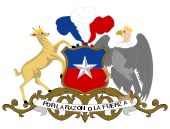Regions of Chile
|
|||||
 |
Chile is divided into 15 regions (in Spanish, regiones; singular región), each of which is headed by an intendant (intendente), appointed by the President.
The regions have formally both a name and a Roman numeral (e.g. IV, fourth), with the numbers originally assigned in sequence from north to south (the recent inclusion of the two newest regions has changed this, see map below). In general, the Roman numeral is used rather than the name. The only exception is the region where the national capital is situated, which is called the Santiago Metropolitan Region (Región Metropolitana de Santiago, or RM).
Regions are divided into provinces, each headed by a governor (gobernador), appointed by the president. There are 53 provinces, in total.
Provinces are further divided into communes, which are governed by municipalities. According to the Chilean constitution, municipalities, each with its own mayor (alcalde), and councilors, known as concejales. elected by the municipality's inhabitants are responsible to administrate one or more communes. There are 346 communes administrated by 345 municipalities. The single commune which is grouped with another is the commune of Antártica, which is combined with the commune of Cabo de Hornos
Contents |
History of the regional structure
The current administrative divisions of Chile were created in 1974 but limited to 13. Previously, Chile was divided into 25 provinces, which were further divided into departments, and then into communes. The new territorial organization was implemented in phases with some initial "pilot regions" beginning to operate in 1974, extending the process on January 1 1976 to the rest of the country. The Santiago Metropolitan Region began to operate in April 1980.
In 2005, reforms to the Constitution eliminated the 13-region limit, and allowed for more regions to be created.
On December 19, 2006 the Congress passed a bill approving the creation of two new regions: one in the north of the country called XV Arica-Parinacota Region, encompassing the provinces of Arica and Parinacota previously part of the Tarapacá Region; and another in the south, formed by the province of Valdivia, formerly part of the Los Lagos Region, called XIV Los Ríos Region (The Rivers Region).[1] The Los Ríos Region became operative on October 2 2007 and the Arica-Parinacota Region started functioning on October 8 2007.
List of regions
| Key | Name | Spanish | Capital |
|---|---|---|---|
| XV | Arica and Parinacota | Región de Arica y Parinacota | Arica |
| I | Tarapacá | Región de Tarapacá | Iquique |
| II | Antofagasta | Región de Antofagasta | Antofagasta |
| III | Atacama | Región de Atacama | Copiapo |
| IV | Coquimbo | Región de Coquimbo | La Serena |
| V | Valparaíso | Región de Valparaíso | Valparaiso |
| VI | O'Higgins | Región del Libertador General Bernardo O'Higgins | Rancagua |
| VII | Maule | Región del Maule | Talca |
| VIII | Biobío | Región del Biobío | Concepción |
| IX | Araucanía | Región de la Araucanía | Temuco |
| XIV | Los Ríos | Región de Los Ríos | Valdivia |
| X | Los Lagos | Región de Los Lagos | Puerto Montt |
| XI | Aisén | Región Aisén del General Carlos Ibáñez del Campo | Coihaique |
| XII | Magallanes and Antártica Chilena | Región de Magallanes y de la Antártica Chilena | Punta Arenas |
| RM | Santiago Metropolitan | Región Metropolitana de Santiago | Santiago |
See also
- ISO 3166-2:CL
- Provinces of Chile
- Communes of Chile
- Patagonia
References
|
||||||||
